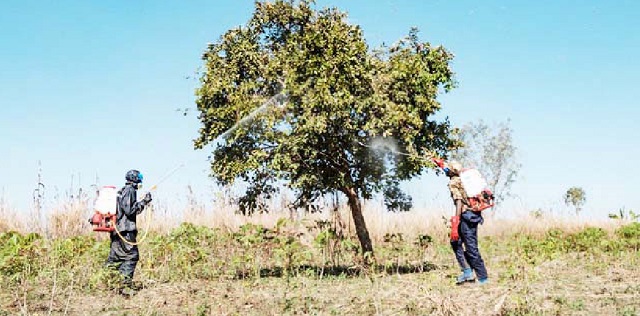
Bee keeping employs 1.2 million Ugandans
Kampala, Uganda | RONALD MUSOKE | The Uganda People’s Defence Forces’ sustained spraying of desert locust swarms across northern Uganda is causing panic among the region’s bee keepers.
The bee keepers through their umbrella body, The Uganda National Apiculture Development Organization (TUNADO), say the chemicals used to kill locusts also kill other insects including bees which are critical in honey production and pollination of plants.
Dickson Biryomumaisho, the executive director of TUNADO said bee keepers in Karamoja where the fight against the locusts began in early February are already affected. He said the pesticides being used to spray the locusts are non-selective pesticides that kill both the target pests (locusts) and the unintended essential insects such as bees.
“Chemicals tend to stay longer in the environment and even if the bees don’t get killed, the bees consume nectar from these plants and somehow bee products are likely to have traces of the chemicals,” he said.
Biryomumaisho said there is need for the government to reconsider its current locust control approach to save the bees. The government embarked on massive spraying in the northern region to kill the locusts that entered the country on Feb.09.
The swarms have since been sighted in 24 districts in the Karamoja sub-region (Amudat, Nakapiripirit, Nabilatuk, Moroto, Kotido, Kaabong, Karenga, Abim and Napak); Teso (Katakwi, Amuria, Soroti, Ngora, Kumi, Bukedea), Acholi (Agago, Kitgum, Pader, Lamwo), Lango (Otuke), Sebei (Bukwo and Kween) and Bugisu (Bulambuli and Sironko Districts).
The government dispatched 18,000 litres each of Chlorpyrifos and Cypermethrin for ground spraying of the locusts in the regions. In addition, the government procured 10,000 litres of Fenitrothion 96% ULV, Ultra Low Volume, a phosphorothioate insecticide that is inexpensive and widely used worldwide, for aerial spraying against locusts.
On March 01, Aerial spraying using Fenitrothion 96 ULV was done at Napeto, Nakachumti Parish, Matany Sub-County in Napak District on March 01. More aerial spraying of the desert locusts was also carried out at Kadonyo, Tapac in Moroto District.
Other chemicals that the government had lined up for aerial spraying include; Malathion, an organophosphate insecticide commonly used to control mosquitoes and a variety of insects that attack fruit, vegetables, landscaping plants, and shrubs; and pyrethroid, a special chemical class often used by pest management professionals.
Biryomumaisho told The Independent on March 09 that the organization had written to the Entomology Department in the agriculture ministry seeking clarification about the safety of bees amidst the ongoing spraying of the locusts in the regions so far affected.
In a rejoinder, Bright Rwamirama, the State Minister for Agriculture in charge of Animal Husbandry had said on March 03 that the chemicals currently being used to kill the adult locusts are biodegradable and dissipate in less than seven days.
However, Biryomumaisho told The Independent that unless the chemicals being sprayed do not target bees at all, he was skeptical about the government’s reaction.
“Bees are insects and the pesticides being used to spray the locusts target all insects and that includes bees,” Biryomumaisho told The Independent.
The areas so far affected by the desert locust invasion are some of Uganda’s top honey producers. A 2012 United Nations Development Programme (UNDP) funded value chain analysis of the honey sub-sector in Uganda found the northern region to produce the highest volumes, about 640 metric tonnes of honey per annum while the central region had the least volume of about 85 metric tonnes. Other honey producing districts include; Yumbe, Nakapiripirit, Pader, Moroto, Amuru, Oyam, Nyadri, Nebbi, Apac and Lira.
The majority of bee keepers in these regions are small scale producers mainly using traditional hives and indigenous management practices to maintain their bee colonies. It is estimated that there are over two million hives in Uganda, 87% of which are traditional log hive with about 66% of them getting colonized per season.
Biryomumaisho said the government’s panic and indiscriminate spraying of the environment in an attempt to eradicate the locusts were likely to put the bee farmers’ livelihood in jeopardy. He said deforestation had already affected the population of bees in northern Uganda noting that the government should have been calculative before spraying.
He says beekeeping employs 1.2 million in Uganda majority of whom are based in northern Uganda. The sub-sector is increasingly turning lucrative. Last year, for instance, the sector contributed up to Shs 60bn to the economy. Although Uganda exports most of its honey to Kenya and the Middle East according to TUNADO, inroads are being made to crack the EU, U.S, Japan and Canadian markets.
But now, Biryomumaisho fears the current spray of the pesticides might prohibit Ugandan honey from making it into some of these markets which have stringent standards. For example, the EU has the national residue monitoring plan which must be met before Ugandan farmers export their honey there.
 The Independent Uganda: You get the Truth we Pay the Price
The Independent Uganda: You get the Truth we Pay the Price



